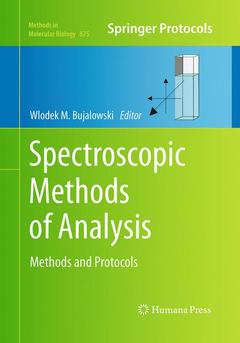Description
Spectroscopic Methods of Analysis, Softcover reprint of the original 1st ed. 2012
Methods and Protocols
Methods in Molecular Biology Series, Vol. 875
Coordinator: Bujalowski Wlodek M.
Language: English
Subjects for Spectroscopic Methods of Analysis:
Support: Print on demand
397 p. · 17.8x25.4 cm · Hardback
Description
/li>Contents
/li>Comment
/li>
Quantitative elucidation of structural, energetic and dynamic aspects of macromolecular interactions is indispensable for understanding the functional activities of biomolecules and their interactions. The optical spectroscopic methods are not confined to small molecules or macromolecules but permit the studies of even the largest biological systems in their full splendor, including the living cell. In, Spectroscopic Methods of Analysis: Methods and Protocols, expert researchers in the field detail many of the methods which are now commonly used to study properties of individual macromolecules, their complexes, organelles, and cells, using optical spectroscopic techniques. These include methods and approaches for experimental and theoretical analyses of fluorescence properties of the examined systems, single molecule approaches, electronic absorption, and electro-optical analyses of macromolecular interactions, structures, and dynamics. Written in the highly successful Methods in Molecular Biology(tm) series format, chapters include introductions to their respective topics, lists of the necessary materials and reagents, step-by-step laboratory protocols, and key tips on troubleshooting and avoiding known pitfalls.
Authoritative and practical, Spectroscopic Methods of Analysis : Methods and Protocols seeks to aid scientists in the further study of optical spectroscopic methods.
Fluorescence Lifetime Imaging Comes of Age How to Do It and How to Interpret It.-Förster Resonance Energy Transfer and Trapping in Selected Systems Analysis by Monte – Carlo Simulation.-Molecular Organization of Polyene Antibiotic Amphotericin B Studied by Means of Fluorescence Technique.-Spectroscopic Probes of RNA Structure and Dynamics.-Fluorescence Methods to Study DNA Translocation and Unwinding Kinetics by Nucleic Acid Motors.-Fluorescence Intensity, Anisotropy, and Transient Dynamic Quenching Stopped-Flow Kinetics.-Using Structure - Function Constraints in FRET Studies of Large Macromolecular Complexes.§.-Illuminating Allostery in Metal Sensing Transcriptional Regulators.-Fluorescence-based Biosensors.-Metal Enhanced Immunoassays.-Initial stages of Angiosperm Greening Monitored by Low-Temperature Fluorescence Spectra and Fluorescence Lifetimes.-Activation of the Mammalian Cells by using Light-sensitive Ion Channels.-Detection of Specific Strains of Viable Bacterial Pathogens by using RNA Bead Assays and Flow Cytometry with 2100 Bioanalyzer.-Photosynthetic Antenna Complex LHCII Studied with Novel Fluorescence Techniques.-Analysis of RNA Folding and Ribonucleoprotein Assembly by Single-Molecule Fluorescence Spectroscopy.-Single-molecule Force Spectroscopy of Polycystic Kidney Disease Proteins.-Single Molecule Detection Approach to Muscle Study: Kinetics of a Single Cross-Bridge During Contraction of Muscle.-Single-Molecule Optical-Trapping Measurements with DNA Anchored to an Array of Gold Nanoposts.-Electro-optical Analysis of Macromolecular Structure and Dynamics.-Cryoradiolysis and Cryospectroscopy for Studies of Heme-oxygen Intermediates in Cytochromes P450.




